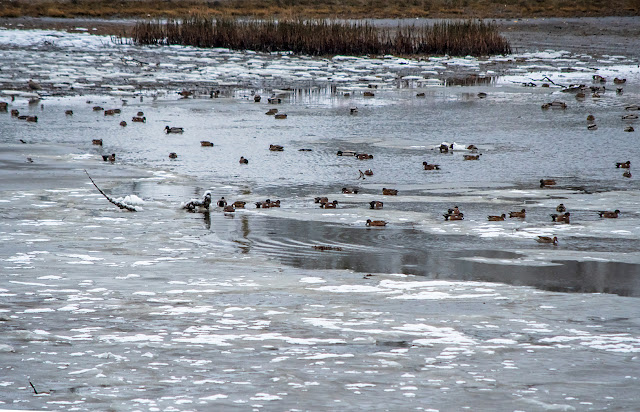Oyster Bay fills a shallow curve in the coastline, with the deepest part of the curve protected by an ancient rock-and-scuttled-ships breakwater. Over time, currents have brought in sand and stones (!), creating a spit that encloses a lagoon, a mud flat at the lowest tides. This area is a favourite resting and feeding for a variety of shorebirds and waterfowl. Around the edges, salt-tolerant marsh plants have taken root; samphire and silver burweed where the water covers them at high tide; tall grasses and gumweed on the higher areas, subject to salt spray but out of the intertidal zone.
 |
| Google maps image. |
This week, much of that lagoon froze over.
 |
| The remains of century-old docks near the dike, where the sandpipers usually hang out. |
It is still snowing, and although daytime temperatures have hovered above freezing, nights are cold. Driving past, I saw a heron standing on a rock surrounded by ice, the fish he hunts in shallow water now safe under a hard window.
~~~~~~~~~~~
Oyster Bay forma una curva en la costa; la parte más amplia está protegida por un viejo rompeolas hecho de piedras y barcos hundidos. Con el tiempo, las corrientes han traido arena y hasta piedras para construir una lengua de tierra que encierra una laguna, más bien un pantano invadido dos veces a diaro por la marea. Este sitio atrae una variedad de aves acuáticas y playeras. Alrededor, donde la marea alta las cubre, plantas halófilas (que toleran la salinidad) se han establecido; Salicornia depressa y Ambrosia chamissonis; donde no les llega la marea, pero sí reciben agua salada llevada por el viento, crecen pastos altos y Grindelia integrifolia con sus flores amarillas.
Esta semana, gran parte de esa laguna se congeló.
- Mapa de Google.
- La vista desde el dique. Hielo cubierto de nieve, en planchas rotas, cubre las plantas de la zona fuera del alcance de la marea. La laguna, donde el agua es de poca profundidad, está congelada. A la izquierda se ven los pilotes con los nidos para las golondrinas purpúreas.
- Donde el agua sigue en forma líquida, patos esperan el regreso de la marea. Por el momento la mayoría son silbones; hay uno que otro pato ánade. Correlimos, que generalmente se encuentran al pie del dique, ahora buscan entre el lodo cerca de la lengua de tierra.
- Los restos de pilotes de un muelle de hace un siglo, atrapados por el hielo. Los correlimos acostumbran congregar aquí. Hoy no.
Y sigue nevando, aunque la temperatura a mediodia llega a subir hasta más de 0°. De noche, regresa el frio. Pasando, vi una garza azul parada en una roca rodeada de hielo; los peces que caza ahora están protegidos bajo una capa transparente.



No comments:
Post a Comment
I'm having to moderate all comments because Blogger seems to have a problem notifying me. Sorry about that. I will review them several times daily, though, until this issue is fixed.
Also, I have word verification on, because I found out that not only do I get spam without it, but it gets passed on to anyone commenting in that thread. Not cool!